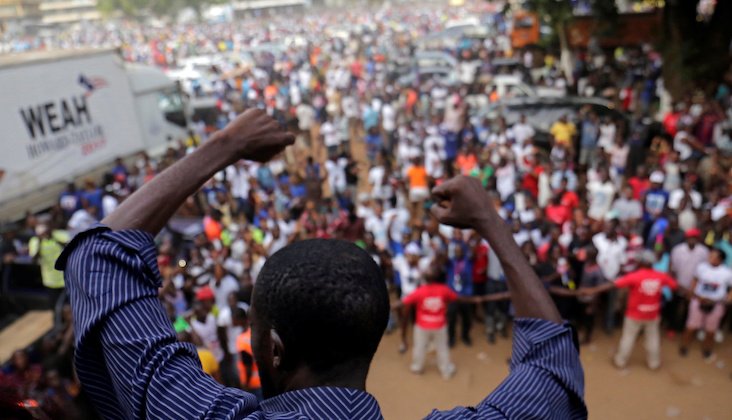The government, under President George Weah, says the theme is meant to celebrate Liberia as a refuge for freed slaves and memorialise black freedom, nationhood as well as the role that Liberia has played in the continent’s pan-African struggles.
The celebration is also centred on a ‘year of return’, which is meant to capitalise on Liberia’s unique history with regards to anti-slavery and pan-Africanism. The approach mirrors that of Ghana, which had a huge economic impact for the country.
However, the celebration does little to recognise and reconcile Liberia’s complex and dual history of settlers and natives, particularly with regards to its ideals of liberty, freedom and self-governance.
The bi-centennial celebration has been largely based on the dominant framing that Liberia was formed when the freed slaves arrived. This framing is aided by very little pre-independence documentation of the nation-state that existed or of ‘people who settlers met’ upon arrival.
‘Uncultured and uncivilised’
To an extent, much of the documentation – mostly by foreign authors – paints a narrative that references indigenous people as an ‘uncultured and uncivilised’ group that stood against the ‘forming of the state’.
For most of Liberia’s early history, indigenous Liberians dealt with systematic oppression and exclusion in society and politics. 200 years later, and after a brutal 14-year civil crisis linked to socio-economic cleavages related to settler-native divide, Liberia is on a path to rebuilding itself.
All these cleavages must be addressed for Liberia to go forward successfully as a united people and a progressive nation.
In its 2010 report, Liberia’s Truth and Reconciliation Commission (TRC), which was formed to promote peace, unity and reconciliation after its 14-year civil war, attributed the “lack of clarity and understanding of Liberia’s history ” as one of the root causes of the conflict.
While the current Liberian state and society is to a large degree no longer as exclusively divided along settler-native lines, limited actions to address reconciliation, war crimes and access to basic services by the majority of the country’s population mean these cleavages still exist.
According to the government’s Pro-Poor Agenda for Prosperity and Development plan, “all these cleavages must be addressed for Liberia to go forward successfully as a united people and a progressive nation”. Thus, in addressing these cleavages, the Liberian government must confront and reconcile the duplicity in the identity and history of both indigenous and settlers.
Erroneous context
In reality however, the history and struggles of indigenous Liberians – who made up to 90% of the population and who were largely discriminated against by the settlers in early Liberian history – have not only been relegated to soundbites, but – in some instances – also been erroneously contextualised.
A prime example is the presidential speech during the launch of the celebration. President Weah said: “As we commemorate our National Bicentennial, let us recollect memories of all of our ancestors — their various ways of life, their respective histories and cultures, and the way they co-existed with each other as long-lost brothers and sisters returned to the land to form a unique and united country.”
Despite what may have been good intentions, statements like this do not reflex the history of discrimination and systematic oppression faced by indigenous Liberians in the first 100 years of the nation’s post-independence period.
The identity of the country is also on the cards. Settlers led and played integral roles in the formation of the country. In fact, Liberia did not have an indigenous president until 100 years after its formation, when Samuel Doe seized power in a bloody coup.
National symbolism and identity
Liberia’s national symbols, such as the flag (a replica of America’s flag, but with one star), the national anthem, and other national symbols and imagery, are reflective of only the settlers’ connections and identity, inadequate reflections of the majority of Liberians who are indigenous. For instance, the national slogan ‘Love of Liberty Brought Us Here’ recognises the settlers’ quest for freedom and self-governance even though the majority of the population are indigenous to the land and weren’t ‘brought’ to the country.
It is noteworthy to mention that discourse around Liberia’s national identity and statehood are as old as the Republic. Somehow, there has never been an agreement on ‘national identity’, but instead, continued framing around it.
A 1974 New York Times archived document reveals former President William R. Tolbert’s attempt to investigate Liberia’s history, including the nation symbols. He opined that the nation’s symbols did not “appropriately reflect our national aspirations and concepts” hence had to be changed.
Liberia’s history is complex, [but] the challenge that persists is the state’s (leadership’s) inability to confront and address this complexity.
Decades later, in 2010, recommendations on national integration by the Truth and Reconciliation Committee suggested the renaming of Liberia’s capital city of Monrovia – named after former President James Monroe – to its previous name, Dukor, and change of the national slogan from ‘Love of Liberty Brought Us Here’ to an all-encompassing one – ‘Love of Liberty Brought Us Together’. The recommendations were never implemented and little has been done to adequately address the issue of national symbolism and identity.
There is no doubt that Liberia’s history is complex, however, the challenge that persists is the state’s (and leadership’s) inability to confront and address this complexity. While it is important that Liberia recognises and celebrates its connection and history with the settlers, the celebration provides an opportunity for the government to reconcile the duplicity of Liberia’s history and address issues around the country’s identity. It is the hope of many that the government will seize this opportunity.

